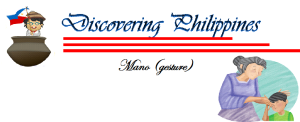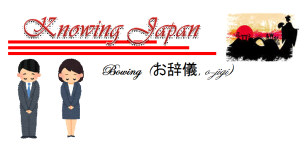Mano or Pagmamano is a gesture used in Filipino culture performed as a sign of respect to elders and as a way of accepting a blessing from the elder. Similar to hand-kissing, the person giving the greeting bows towards the offered hand of the elder and presses his or her forehead on the elder’s hand. Usually performed with the right hand, the person showing respect may ask “Mano po” to the elder in order to ask permission to initiate the gesture. Typically someone may mano to his or her older relatives upon entry into their home or upon seeing them.
The word “mano” is Spanish for “hand” while the word “po” is often used in Filipino culture and language at the end of each sentence as a sign of respect when addressing someone older. Put together, “mano po” literally translates to “your hand please” as the greeting initiates the gesture of touching the back of the hand of an elder lightly on one’s forehead. An identical tradition is followed in neighbouring Indonesia and Malaysia called “salim” and “salam” respectively, suggesting that the Mano po tradition dates to precolonial times.
In today’s Philippine setting, the “mano” is still used by Filipinos as a sign of respect to their elders. It is usually done when the elder is seen for the first time in the day or upon entering a house or gathering. There is no age limit for the usage of the mano, but it is usually practiced on those older by two generations or more. Adults may occasionally bless people older than them though the mano practice is mainly done by the youth.
By offering your hand to “mano”, you are allowing yourself to be subservient to the elder to accept their blessing and wisdom. It is considered impolite if one does not exercise the custom of “pagmamano” when entering the home of an elder or after seeing them at a gathering.
The respect for elders stems from the high value of family in Filipino culture.
The “mano po” gesture is usually followed by a response of “God bless you” or “May the Lord have mercy on you” by the elder; the sign of the cross may be made over the recipient. The latter response of “May the Lord have mercy on you” is used when the pagmamano is performed with both hands to ask an elder’s pardon and forgiveness. With both hands, the younger person takes the elder’s hands and lifts them to the forehead to formally ask forgiveness for an offence. This may be done whilst kneeling and weeping. This is the highest form of the pagmamano.
Bowing is considered extremely important in Japan, Basic bows are performed with the back straight and the hands at the sides (boys and men) or clasped in the lap (girls and women), and with the eyes down. Bows originate at the waist. Generally, the longer and deeper the bow, the stronger the emotion and the respect expressed. Bows can be generally divided into three main types: informal, formal, and very formal. Informal bows are made at about a fifteen degree angle or just tilt over one’s head to the front, and more formal bows at about thirty degrees. Very formal bows are deeper.
The etiquette surrounding bowing, including the length and depth of bow, and the appropriate response, is exceedingly complex. For example, if the other person maintains his or her bow for longer than expected (generally about two or three seconds), it is polite to bow again, upon which one may receive another bow in return. This often leads to a long exchange of progressively lighter bows.
Generally speaking, an inferior bows longer, more deeply and more frequently than a superior. A superior addressing an inferior will generally only nod the head slightly, while some superiors may not bow at all and an inferior will bend forward slightly from the waist. Bows of apology tend to be deeper and last longer than other types of bow. They tend to occur with frequency during the apology, generally at about 45 degrees with the head lowered and lasting for at least the count of three, sometimes longer.
Bows of thanks follow the same pattern. In extreme cases a kneeling bow is performed; this bow is sometimes so deep that the forehead touches the floor. When dealing with non-Japanese people, many Japanese will shake hands. Since many non-Japanese are familiar with the custom of bowing, this often leads to a combined bow and handshake which can be quite complicated to execute. Bows may be combined with handshakes or performed before or after shaking hands.







